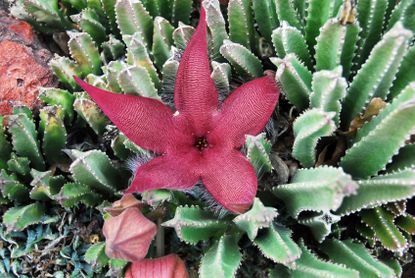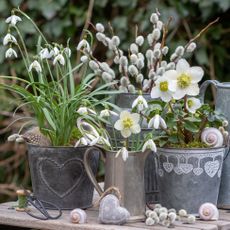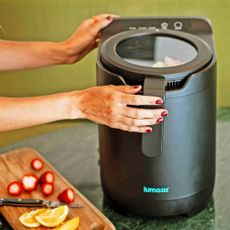Starfish Flower Cactus: Tips For Growing Starfish Flowers Indoors


Starfish cacti (Stapelia grandiflora) are also more morbidly called the carrion flower. These stinky, but spectacular, plants share similar traits to those from the carnivorous family in that they possess insect attracting flora (but are not carnivorous), which range in size from a couple of inches (5 cm.) high to plants that bear 12-inch (30 cm.) wide flowers.
This plant species is native to South Africa, so growing starfish flowers usually requires warm, humid temperatures or a specialized greenhouse environment.
Starfish Flower Cactus
These plants aren't exactly cactus, but are members of the succulent group of plants. They are soft stemmed plants without spines spreading out from a central point. They are thickly skinned and resemble carrion flesh. Starfish flower cactus may produce amazing five-petaled flowers that exude a rather unpleasant odor.
The scent attracts flies and other insects, which pollinate the blooms. Flowers are red to brown and may be mottled with a couple of colors. Stapelia is the family name of the starfish flower cactus. The “gigantea” is the most commonly collected, as a showy specimen with foot wide flowers.
Uses of Starfish Cactus
The flowers ripen to a rather horrifying odor after a couple of days. This reek is attractive to insects that seek out dead organic material. If you have a fruit fly infestation or other pest, try moving your stinky plant darling into the area. The insects are drawn to the carrion stench and sit mesmerized on the flower unable to move.
More common uses of starfish cactus are as an ornamental specimen that is quite a conversation piece. The wide succulent branches have little ornamental use themselves, but once the flowers arrive in summer, the plant has a high wow factor. Of course, this is when you must cope with the smell, but you can move it outside if the odor is too offensive. Just remember to bring it back inside if you live in any zone outside of USDA plant hardiness zone 9 to 11.
Starfish Flower Plant Care
Growing starfish flowers as houseplants is ideal in most zones of the United States. You can move them outside in the heat of summer or grow them in a greenhouse. These starfish flowers are easy to care for and thrive in a variety of light conditions. They will perform well in full to partial sun. Morning light is the best with some protection from harsh midday rays.
Gardening tips, videos, info and more delivered right to your inbox!
Sign up for the Gardening Know How newsletter today and receive a free download of our DIY eBook "Bring Your Garden Indoors: 13 DIY Projects For Fall And Winter".
The name starfish flower cactus is misleading. The plant does need consistent moisture unlike its true cacti cousins. Starfish flowers also like to have crowded roots, so keep them in a 4- to 6-inch (10 to 15 cm.) pot with well-drained soil. Fertilize with a half dilution of indoor plant food in early spring.
Growing Starfish Flowers from Cuttings
If you can handle the smell, you can let the flowers die back and allow seeds to form. Collect the seeds and start them in a warm area to propagate more of these interesting plants. Much easier still is propagation by cuttings. Remove a 3- to 4-inch (7.5 to 10 cm.) section of stem and let the cut end callus. Put the cut end into peat which has been lightly moistened.
Place the potted cutting in low light and keep the soil just damp, but not too moist or it will rot. In time the cutting will become a plant. Repot the baby plant in regular soil and continue with recommended starfish flower plant care. This is a less smelly method of growing starfish flowers and allows you to share this entrancing plant with friends and family.

Bonnie Grant is a professional landscaper with a Certification in Urban Gardening. She has been gardening and writing for 15 years. A former professional chef, she has a passion for edible landscaping.
-
 Grow A Container Winter Wonderland: 7 Best Winter Flowers For Pots With Cool-Season Cheer
Grow A Container Winter Wonderland: 7 Best Winter Flowers For Pots With Cool-Season CheerContainers don’t need to go into hibernation in colder months – there’s still plenty of floral life to be enjoyed! We round up some of the very best winter flowers for pots
By Tonya Barnett
-
 How To Buy The Best Electric Composter: Read This Before Spending $100s On A Countertop Food Recycler
How To Buy The Best Electric Composter: Read This Before Spending $100s On A Countertop Food RecyclerElectric composters and countertop food recyclers offer a super-fast solution to tackling food waste – and can help create nutrient-rich compost. Choose the best model for your needs with our expert guide.
By Melanie Griffiths